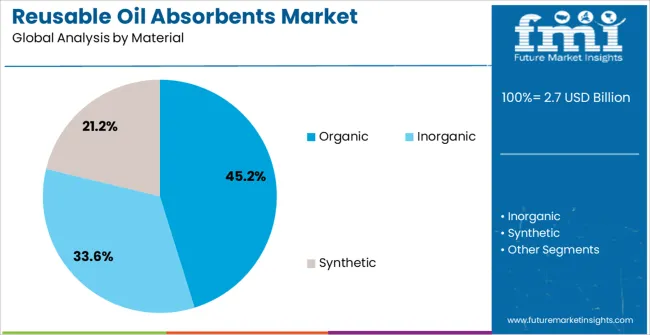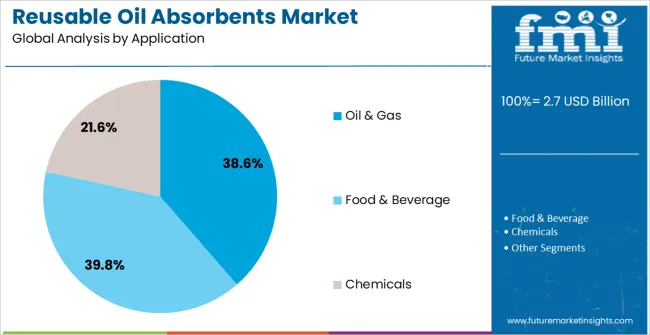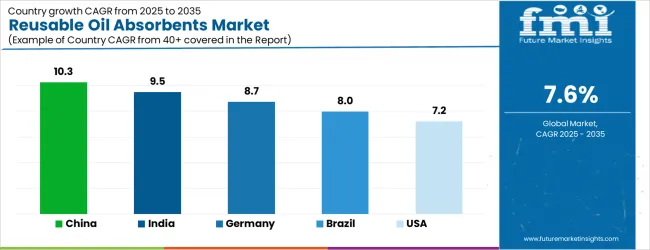The Reusable Oil Absorbents Market is estimated to be valued at USD 2.7 billion in 2025 and is projected to reach USD 5.6 billion by 2035, registering a compound annual growth rate (CAGR) of 7.6% over the forecast period.

| Metric | Value |
|---|---|
| Reusable Oil Absorbents Market Estimated Value in (2025 E) | USD 2.7 billion |
| Reusable Oil Absorbents Market Forecast Value in (2035 F) | USD 5.6 billion |
| Forecast CAGR (2025 to 2035) | 7.6% |
The Reusable Oil Absorbents market is experiencing robust growth, driven by increasing environmental regulations, heightened awareness of oil spill management, and the growing need for sustainable waste handling solutions. Industries are adopting reusable absorbents to reduce operational costs while minimizing environmental impact associated with single-use products. Technological advancements in absorbent materials, including organic and synthetic blends, are improving absorption efficiency, durability, and reusability, enabling extended service life and higher cost-effectiveness.
Rising demand from sectors such as oil and gas, manufacturing, and transportation is creating a strong market pull. Regulatory compliance for spill containment and workplace safety is further encouraging the adoption of reusable solutions.
Organizations are also integrating these absorbents into broader environmental management programs, contributing to operational sustainability and efficiency As industries increasingly prioritize cost-effective, eco-friendly solutions for oil and chemical spill mitigation, the Reusable Oil Absorbents market is expected to experience steady expansion, supported by continued product innovation and growing adoption across key end-use sectors.
The reusable oil absorbents market is segmented by type, material, application, end use, and geographic regions. By type, reusable oil absorbents market is divided into Oil Absorbent Mats, Oil Absorbent Pads, Absorbent Socks, Absorbent Cushion, Absorbent Rolls, Absorbent Booms, and Wet Mops. In terms of material, reusable oil absorbents market is classified into Organic, Inorganic, and Synthetic. Based on application, reusable oil absorbents market is segmented into Oil & Gas, Food & Beverage, and Chemicals. By end use, reusable oil absorbents market is segmented into Industrial and Residential. Regionally, the reusable oil absorbents industry is classified into North America, Latin America, Western Europe, Eastern Europe, Balkan & Baltic Countries, Russia & Belarus, Central Asia, East Asia, South Asia & Pacific, and the Middle East & Africa.

The oil absorbent mats segment is projected to hold 25.7% of the market revenue in 2025, establishing it as the leading type. Its market dominance is being driven by the ease of deployment, high absorption capacity, and versatility across multiple applications, including spill containment, maintenance operations, and industrial leak management. Mats provide a practical and reusable solution for areas with frequent oil or chemical leaks, reducing material consumption and disposal costs.
Advances in material engineering have enhanced durability, chemical resistance, and absorption efficiency, further reinforcing their adoption. Organizations are leveraging oil absorbent mats to comply with environmental regulations and improve workplace safety while achieving operational cost savings.
The ability to integrate mats into broader spill response protocols and to reuse them multiple times without significant performance loss strengthens their position in the market As demand for efficient, sustainable, and cost-effective absorbent solutions grows across industries, oil absorbent mats are expected to maintain their leading market share and continued adoption.

The organic material segment is anticipated to account for 45.2% of the market revenue in 2025, making it the leading material category. Growth in this segment is driven by the eco-friendly and biodegradable characteristics of organic absorbents, which enable organizations to manage oil spills while minimizing environmental impact.
Materials such as natural fibers and plant-based composites offer high absorption rates, durability, and compatibility with reusable applications. Their adoption is supported by increasing environmental regulations and sustainability initiatives across industries, particularly in oil and gas, transportation, and manufacturing sectors.
Organic absorbents can be easily disposed of or regenerated for multiple uses, improving cost efficiency and reducing operational waste As industries focus on green practices and regulatory compliance, the organic material segment is expected to sustain its leadership, with continued innovation in composition and performance enhancing adoption across diverse spill management applications.

The oil and gas application segment is projected to hold 38.6% of the market revenue in 2025, establishing it as the leading end-use industry. Growth in this segment is being driven by the frequent occurrence of oil spills, leakages, and maintenance operations that require efficient absorbent solutions. Reusable oil absorbents are being deployed for containment, cleanup, and spill prevention, which reduces environmental hazards and operational downtime.
The ability to reuse absorbents multiple times provides cost savings and reduces material waste in a high-volume industry. Compliance with stringent environmental and safety regulations further reinforces their adoption.
Technological advancements in absorbent efficiency, durability, and chemical resistance have enhanced performance in demanding oil and gas environments As energy production and transportation activities expand globally, the oil and gas sector is expected to remain the primary driver of reusable oil absorbent demand, with continued emphasis on operational safety, sustainability, and cost-effective spill management solutions.
Reusable oil absorbents market is expected to gain traction over the forecast period owing to increasing industrialization and growing demand from the oil and gas sector. Reusable oil absorbent’s mats, pads and socks soak the waste oil to prevent slips and falls.
Reusable oil absorbents follow a closed loop laundering process, where the recovered oils are recycled and the absorbents are cleaned and used again and again for absorbing oil. The different benefits of reusable oil absorbents are low cost compared to disposals, they save time with a managed program, prevent slips, trips and falls and eliminate the waste stream.
Reusable oil absorbents are available in different types, such as mats, pads, absorbent socks, absorbent cushion and absorbent booms. These absorbents are used by various end users involving oil & gas, food and beverage and chemicals. Oil absorbent pads are used for low lint applications and in traffic areas as they are ideal in repelling the water-based fluids.

| Country | CAGR |
|---|---|
| China | 10.3% |
| India | 9.5% |
| Germany | 8.7% |
| Brazil | 8.0% |
| USA | 7.2% |
| UK | 6.5% |
| Japan | 5.7% |
The Reusable Oil Absorbents Market is expected to register a CAGR of 7.6% during the forecast period, exhibiting varied country level momentum. China leads with the highest CAGR of 10.3%, followed by India at 9.5%. Developed markets such as Germany, France, and the UK continue to expand steadily, while the USA is likely to grow at consistent rates. Japan posts the lowest CAGR at 5.7%, yet still underscores a broadly positive trajectory for the global Reusable Oil Absorbents Market. In 2024, Germany held a dominant revenue in the Western Europe market and is expected to grow with a CAGR of 8.7%. The USA Reusable Oil Absorbents Market is estimated to be valued at USD 946.9 million in 2025 and is anticipated to reach a valuation of USD 946.9 million by 2035. Sales are projected to rise at a CAGR of 0.0% over the forecast period between 2025 and 2035. While Japan and South Korea markets are estimated to be valued at USD 133.7 million and USD 81.9 million respectively in 2025.

| Item | Value |
|---|---|
| Quantitative Units | USD 2.7 Billion |
| Type | Oil Absorbent Mats, Oil Absorbent Pads, Absorbent Socks, Absorbent Cushion, Absorbent Rolls, Absorbent Booms, and Wet Mops |
| Material | Organic, Inorganic, and Synthetic |
| Application | Oil & Gas, Food & Beverage, and Chemicals |
| End Use | Industrial and Residential |
| Regions Covered | North America, Europe, Asia-Pacific, Latin America, Middle East & Africa |
| Country Covered | United States, Canada, Germany, France, United Kingdom, China, Japan, India, Brazil, South Africa |
| Key Companies Profiled | Closed Loop Recycling, ITU AbsorbTech, Kimberly-Clark, Brent Industries, US Sorbents, Textile Absorbent Products, New Pig, Zhejiang Jeenor New Material, and Konkan Technical Supplies (K-TECH) |
The global reusable oil absorbents market is estimated to be valued at USD 2.7 billion in 2025.
The market size for the reusable oil absorbents market is projected to reach USD 5.6 billion by 2035.
The reusable oil absorbents market is expected to grow at a 7.6% CAGR between 2025 and 2035.
The key product types in reusable oil absorbents market are oil absorbent mats, oil absorbent pads, absorbent socks, absorbent cushion, absorbent rolls, absorbent booms and wet mops.
In terms of material, organic segment to command 45.2% share in the reusable oil absorbents market in 2025.






Our Research Products

The "Full Research Suite" delivers actionable market intel, deep dives on markets or technologies, so clients act faster, cut risk, and unlock growth.

The Leaderboard benchmarks and ranks top vendors, classifying them as Established Leaders, Leading Challengers, or Disruptors & Challengers.

Locates where complements amplify value and substitutes erode it, forecasting net impact by horizon

We deliver granular, decision-grade intel: market sizing, 5-year forecasts, pricing, adoption, usage, revenue, and operational KPIs—plus competitor tracking, regulation, and value chains—across 60 countries broadly.

Spot the shifts before they hit your P&L. We track inflection points, adoption curves, pricing moves, and ecosystem plays to show where demand is heading, why it is changing, and what to do next across high-growth markets and disruptive tech

Real-time reads of user behavior. We track shifting priorities, perceptions of today’s and next-gen services, and provider experience, then pace how fast tech moves from trial to adoption, blending buyer, consumer, and channel inputs with social signals (#WhySwitch, #UX).

Partner with our analyst team to build a custom report designed around your business priorities. From analysing market trends to assessing competitors or crafting bespoke datasets, we tailor insights to your needs.
Supplier Intelligence
Discovery & Profiling
Capacity & Footprint
Performance & Risk
Compliance & Governance
Commercial Readiness
Who Supplies Whom
Scorecards & Shortlists
Playbooks & Docs
Category Intelligence
Definition & Scope
Demand & Use Cases
Cost Drivers
Market Structure
Supply Chain Map
Trade & Policy
Operating Norms
Deliverables
Buyer Intelligence
Account Basics
Spend & Scope
Procurement Model
Vendor Requirements
Terms & Policies
Entry Strategy
Pain Points & Triggers
Outputs
Pricing Analysis
Benchmarks
Trends
Should-Cost
Indexation
Landed Cost
Commercial Terms
Deliverables
Brand Analysis
Positioning & Value Prop
Share & Presence
Customer Evidence
Go-to-Market
Digital & Reputation
Compliance & Trust
KPIs & Gaps
Outputs
Full Research Suite comprises of:
Market outlook & trends analysis
Interviews & case studies
Strategic recommendations
Vendor profiles & capabilities analysis
5-year forecasts
8 regions and 60+ country-level data splits
Market segment data splits
12 months of continuous data updates
DELIVERED AS:
PDF EXCEL ONLINE
Reusable Water Bottle Market Forecast and Outlook 2025 to 2035
Reusable Box Market Forecast and Outlook 2025 to 2035
Reusable Crate Welding Lines Market Size and Share Forecast Outlook 2025 to 2035
Reusable Transport Packs Market Size and Share Forecast Outlook 2025 to 2035
Reusable Grocery Tote Market Analysis - Size and Share Forecast Outlook 2025 to 2035
Reusable Period Panties Market Analysis - Size, Share, and Forecast Outlook 2025 to 2035
Reusable Tumblers Market Size and Share Forecast Outlook 2025 to 2035
Reusable Laparoscopic Instruments Market is segmented by Reusable Laparoscopic Scissors and Reusable Hand Instruments from 2025 to 2035
Reusable Incontinence Products Market Analysis - Size, Share & Forecast 2025 to 2035
Reusable Nursing Pads Market Size and Share Forecast Outlook 2025 to 2035
Reusable Cold Chain Packaging Market Size and Share Forecast Outlook 2025 to 2035
Reusable Wine Bags Market Size and Share Forecast Outlook 2025 to 2035
Reusable Packing Market Size, Share & Forecast 2025 to 2035
Reusable Straws Market Analysis - Trends, Growth & Forecast 2025 to 2035
Reusable Sanitary Pads Market Growth - Size, Demand & Forecast 2025 to 2035
Reusable Egg Containers Market Trends – Growth & Forecast 2025 to 2035
A Detailed Global Analysis of Brand Share for the Reusable Incontinence Products Market
A Detailed Global Analysis of Brand Share for the Reusable Period Panties Market
Industry Share Analysis for Reusable Wine Bags Companies
Evaluating Reusable Cold Chain Packaging Market Share & Provider Insights

Thank you!
You will receive an email from our Business Development Manager. Please be sure to check your SPAM/JUNK folder too.
Chat With
MaRIA